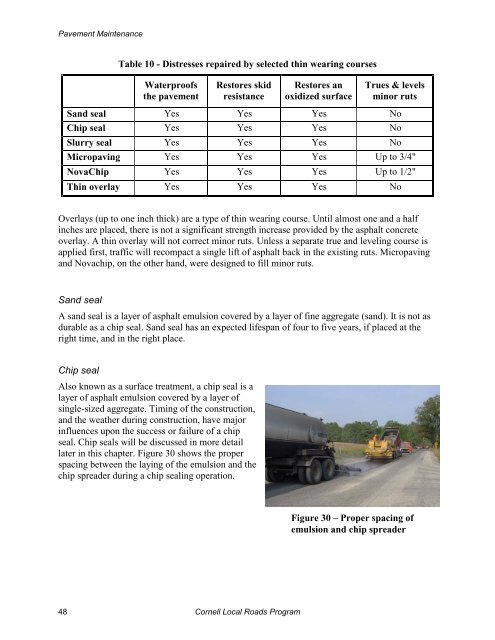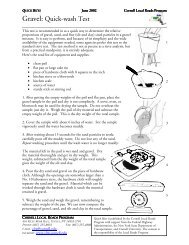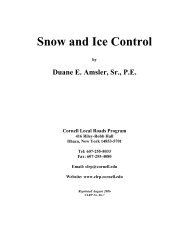Pavement Maintenance - Cornell Local Roads Program - Cornell ...
Pavement Maintenance - Cornell Local Roads Program - Cornell ...
Pavement Maintenance - Cornell Local Roads Program - Cornell ...
Create successful ePaper yourself
Turn your PDF publications into a flip-book with our unique Google optimized e-Paper software.
<strong>Pavement</strong> <strong>Maintenance</strong><br />
Table 10 - Distresses repaired by selected thin wearing courses<br />
Waterproofs<br />
the pavement<br />
Restores skid<br />
resistance<br />
48 <strong>Cornell</strong> <strong>Local</strong> <strong>Roads</strong> <strong>Program</strong><br />
Restores an<br />
oxidized surface<br />
Trues & levels<br />
minor ruts<br />
Sand seal Yes Yes Yes No<br />
Chip seal Yes Yes Yes No<br />
Slurry seal Yes Yes Yes No<br />
Micropaving Yes Yes Yes Up to 3/4"<br />
NovaChip Yes Yes Yes Up to 1/2"<br />
Thin overlay Yes Yes Yes No<br />
Overlays (up to one inch thick) are a type of thin wearing course. Until almost one and a half<br />
inches are placed, there is not a significant strength increase provided by the asphalt concrete<br />
overlay. A thin overlay will not correct minor ruts. Unless a separate true and leveling course is<br />
applied first, traffic will recompact a single lift of asphalt back in the existing ruts. Micropaving<br />
and Novachip, on the other hand, were designed to fill minor ruts.<br />
Sand seal<br />
A sand seal is a layer of asphalt emulsion covered by a layer of fine aggregate (sand). It is not as<br />
durable as a chip seal. Sand seal has an expected lifespan of four to five years, if placed at the<br />
right time, and in the right place.<br />
Chip seal<br />
Also known as a surface treatment, a chip seal is a<br />
layer of asphalt emulsion covered by a layer of<br />
single-sized aggregate. Timing of the construction,<br />
and the weather during construction, have major<br />
influences upon the success or failure of a chip<br />
seal. Chip seals will be discussed in more detail<br />
later in this chapter. Figure 30 shows the proper<br />
spacing between the laying of the emulsion and the<br />
chip spreader during a chip sealing operation.<br />
Figure 30 – Proper spacing of<br />
emulsion and chip spreader





